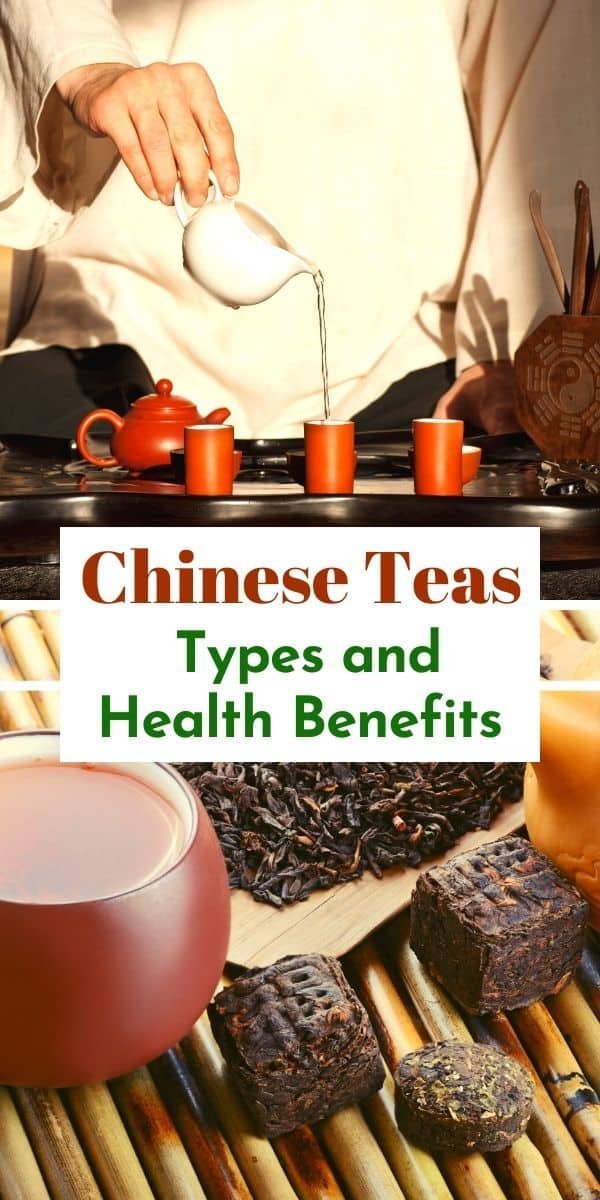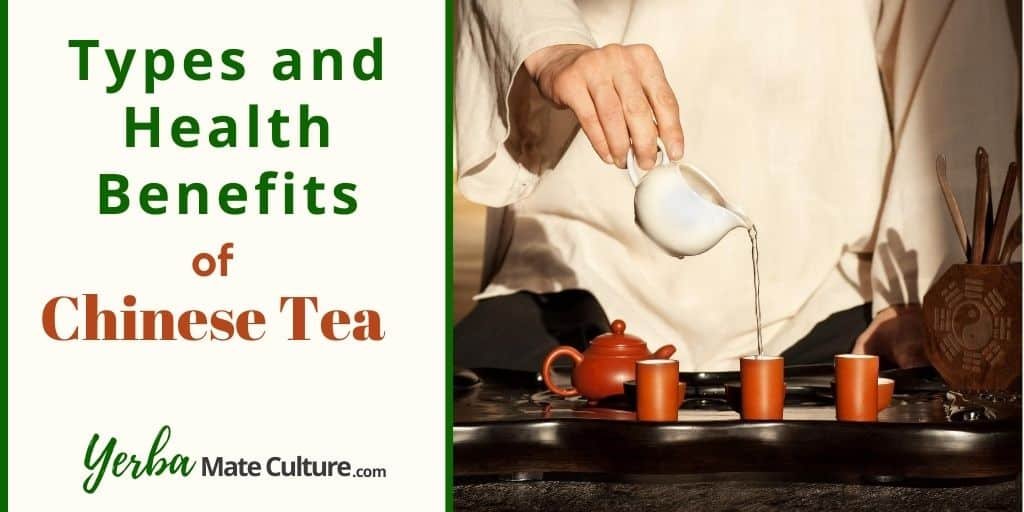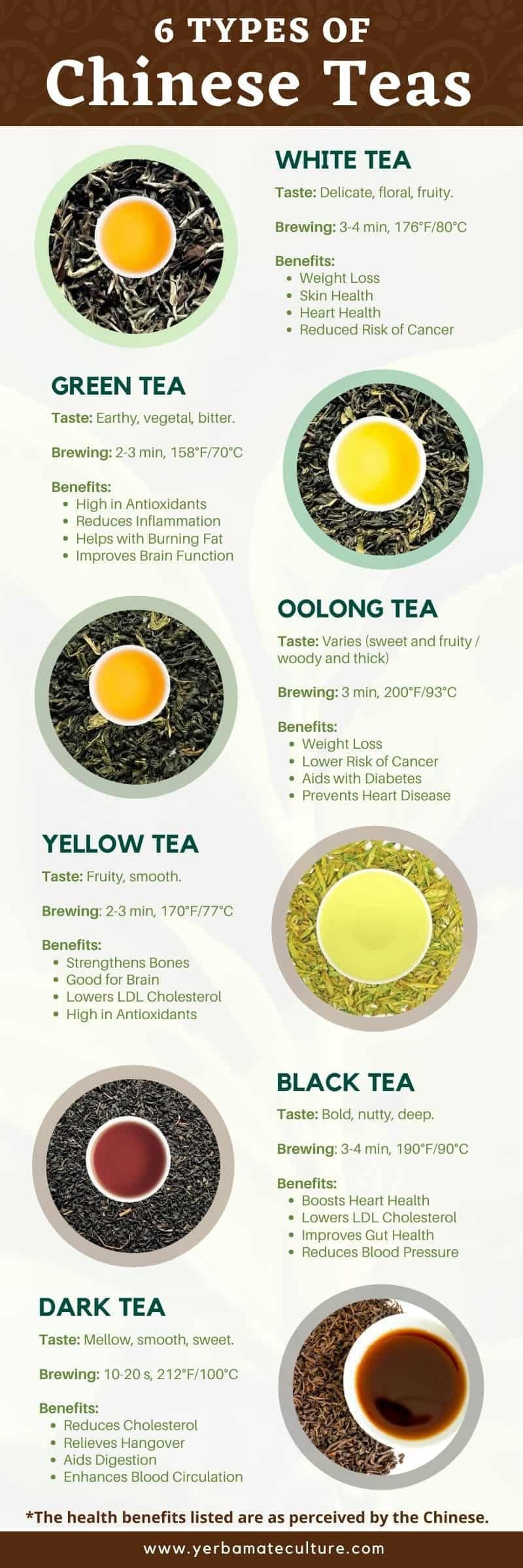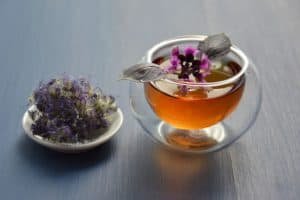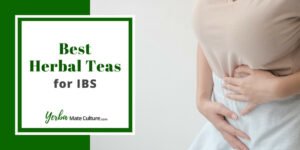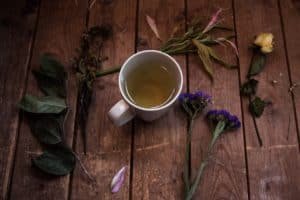I’ve had the privilege of touring the Longjing Tea plantations in Hangzhou, China, some years ago. At the end of the visit, I was invited to drink hot tea made from freshly picked tea leaves, at noon, on that sunny April day.
It is the Chinese traditional way of greeting and treating visitors with respect. At that time I couldn’t fully appreciate the health benefits of Chinese tea.
Now that I do, I’d like to share this knowledge with you along with a glimpse at the different types of Chinese teas as well as the tea culture, ceremonies, and herbal teas used in Traditional Chinese Medicine (TCM).
You don’t have to be Chinese to learn and enjoy the medicinal benefits of these teas. Nowadays, they are widely available online, so you can just order some and try them out at home.
Chinese Tea Tradition
The Chinese have deeply rooted traditions. Virtually everything is linked to history or an event that shaped what is done and how it is done.
Take the tea-drinking tradition, for example. The culture surrounding it is so strong that centuries later tea consumption remains a practice of daily life.
The Tale of Tea
The introduction of tea is credited to Emperor Shennong, also known as one of the founding fathers of Chinese culture. He lived over 5000 years ago.
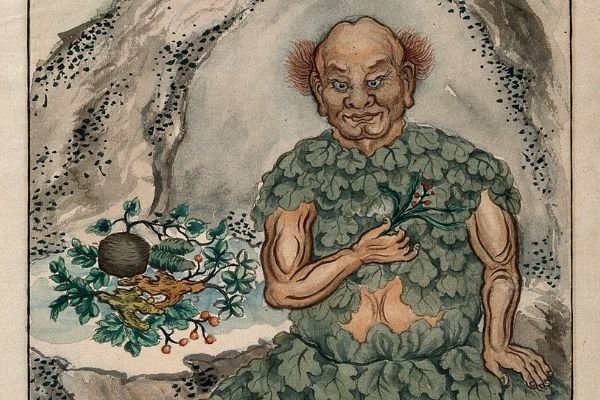
According to the tale, one day he was boiling water, and wild leaves accidentally fell into it. As a herbalist, he was eager to find out how that mixture would taste. So he drank it and realized it made him feel refreshed and energized.
And from that day (about 2737 BC), tea was invented according to legend.
Chinese Tea Culture and How Tea is Prepared
Today, the Chinese drink tea for relaxation, natural healing, and quenching thirst – even on a 100 degrees hot summer day!
Others may see it as just an act of sipping on a liquid brewed from leaves. However, it’s an integral part of life for the people.
Drinking tea is a way to re-energize, savour life, show kindness, humility, morality, strengthen relationships, connect with the inner self (spirituality), and attain the joy of the spirit.
There’s an old saying in China that tea, or “chá (茶),” is one of the seven necessities for starting one’s day.
Chinese tea culture refers to the different ways of preparing tea, the equipment used, and the occasions when tea is consumed in China. There even exists a Book of Tea describing the tea ceremony and the way and morality of drinking tea.
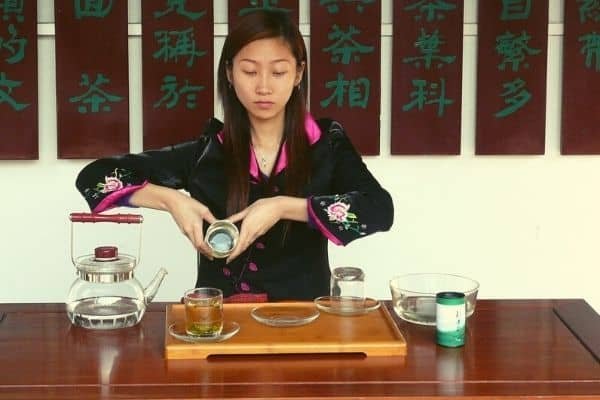
There are different types of Chinese teas based on the way the leaves are prepared, processed, and brewed.
Today, the standard or informal way to prepare tea is by adding loose tea leaves to a pot of piping hot water and allowing it to sit (brew) for a few minutes. Both fresh and quailed (dried) leaves can be used.
The two main formal methods of brewing Chinese tea are:
- Chaou brewing is generally used to prepare delicate and medicinal teas or for tea tastings. The tea is brewed in a chaou, which is a three-piece teaware set consisting of a lid, cup/bowl, and a saucer (also commonly called a Gaiwan or a Zhong).
- Gongfucha brewing is tea brewed in a Yixing clay teapot for welcoming guests or private enjoyment. This formal method is generally used for steeping Oolong and Dark tea.
Chinese tea ceremonies
The Chinese tea ceremony, also called the Way of Tea, is largely influenced by Taoism. The ceremony is an old Chinese art tradition and refers to a cultural event where tea leaf is ceremonially prepared and presented by tea masters.
Tea also plays an important role in both engagements and weddings for Chinese people.

The tea ceremonies depict harmony, spirituality, peace, purity, and the enjoyment of tea both in an informal and formal setting. The tools, such as the bamboo and the porcelain tea sets, are also important parts of the ceremonies.
Traditional Chinese Medicine and Tea
Tai chi, acupuncture, and teas are important parts of traditional Chinese medicine (TCM). Various studies on teas used in TCM suggest they can help address a range of health problems.
The Chinese believe that an imbalance of Qi, the vital force of life in the body, can cause diseases and illnesses. Like tai chi and acupuncture, Chinese herbal teas and remedies are used to regain the balance of Qi.
So what does western medicine say about Chinese teas?
Recent research indicates that these traditional remedies truly have some powerful health benefits. Continue reading to find out more about the benefits of each type of tea.
Types of Chinese Tea (from Tea Plant)
Do not underestimate the powerful potential of tea leaves. For one, they are rich in anti-inflammatory and antioxidant agents that are great for immune health.
Research shows that drinking various types of Chinese teas is associated with multiple physical and emotional health benefits, from aiding in weight loss to reducing anxiety.
Let’s take a look at 6 types of teas made from tea leaves (Camellia sinensis), how to prepare them, and their potential health benefits.
White Tea
White tea (‘bai cha’) is allowed to wither and dry before use. Two of the best white teas are White Hair Silver Needle and White Peony and are produced in Fujian province.
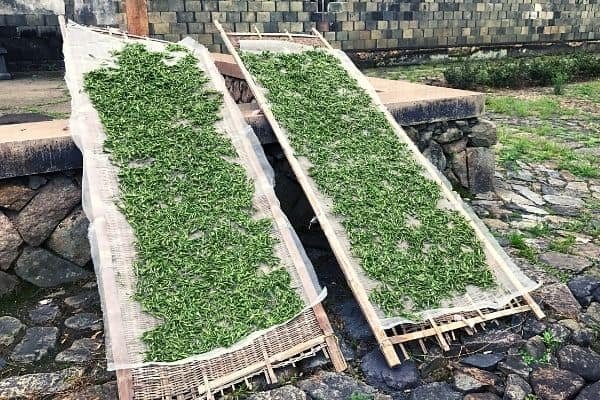
Chinese believe white tea can aid in clearing toxic heat and reducing fatigue.
The potential health benefits of white tea have been studied as well, and include reduced risk of heart and neurodegenerative diseases, healthier skin, and reduced risk of cancer. It can also help with weight loss and supporting healthy bones.
White teas are known for their unique aromas and delicate floral-fruity flavors.
How to Prepare It
To prepare some white tea, brew it in a glass vessel or teapot with hot water (176°F or 80°C) for about 3-4 minutes.
You can find both White Hair Silver Needle and White Peony tea on Amazon.
Here is a guide that explains more about the differences between white and green tea.
Green Tea
Green tea is the oldest type of Chinese tea. The leaves are processed by withering, panning, rolling, and drying in woks or drying machines. This is carried out to remove almost all the moisture and bring out the natural aroma, green color, and green vegetal flavor profile.
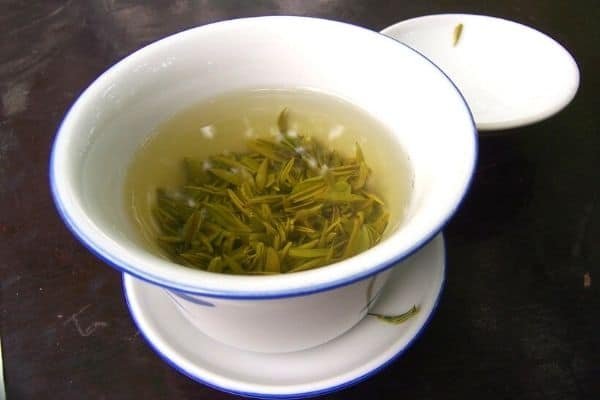
Some of the most famous green teas are West Lake Longjing tea, Maojian tea, and Sweet Dew of Mengding.
Green tea is often considered the healthiest tea because it is rich in antioxidants and nutrients that are good for the body.
Chinese believe that that it can help clear toxic heat, reduce inflammation, help in fat loss, improve brain function, and lower the risk of cancer.
How to Prepare It
Green tea leaves are usually brewed in hot water (158°F or 70°C) for about 2-3 minutes and re-brewed if needed.
If you want to try some high-quality Chinese green tea, I can recommend this Organic Longjing West Lake Dragon Well Green Tea available on Amazon.
Jasmine green tea is also a popular beverage in China. It is made by infusing green tea with jasmine flowers.
Yellow Tea
Yellow is a rare and expensive variety of tea.
It is made with a similar process to green tea except with an added step of encasing and steaming the tea. This way it is oxidized slowly before being heated to stop the oxidizing process.
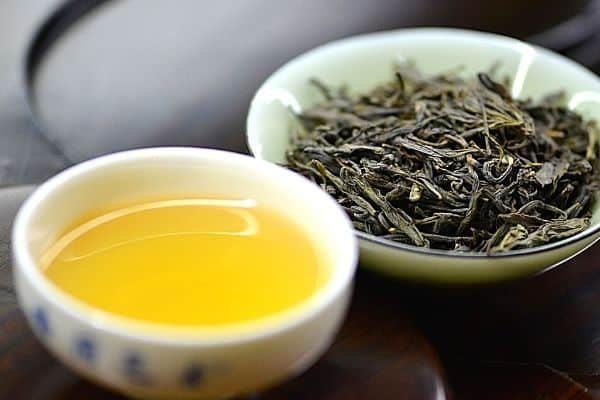
The process gives the tea leaves a yellowish color during drying and its taste is more mellow than most green teas. It also lacks the grassy notes typical to green teas.
According to the Chinese, yellow tea is especially good for strengthening the bones and teeth, lowering bad cholesterol, protecting the brain from strokes, and improving cognitive function.
How to Prepare It
You can prepare yellow tea by brewing the leaves for 2 to 3 minutes in water that is about 170°F or 77°C.
Oolong Tea
Oolong teas (‘qing cha’ or ‘wu long cha’) are semi-oxidized teas (oxidized on a scale between around 5% and 70 %). They are produced mainly in Fujian, Guangdong, and Taiwan.
To process the tea, the leaves are wilted, bruised, partially oxidized, rolled, and dried.
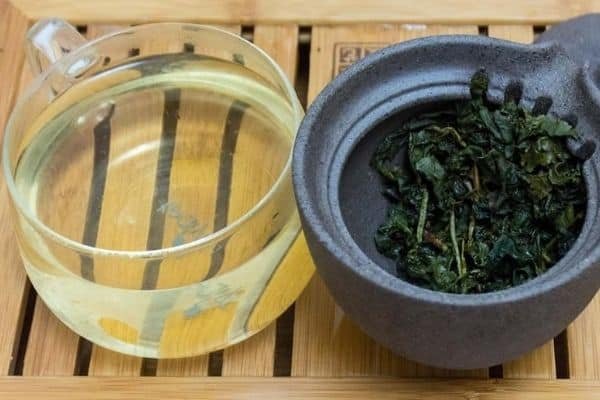
After drying, the dark Chinese oolongs (e.g. Wuyi Rock Oolongs such as Shui Xian, Rou Gui, and Big Red Robe) are roasted over charcoal. The greener oolongs (such as Tie Guan Yin) are sometimes charcoal roasted and sometimes left green.
Oolong teas can help with weight management, lower the risk of cancer, diabetes, and heart disease, and prevent bone loss because of their antioxidant and anti-inflammatory effects on the body.
Greener oolongs, typically oxidized to about 20%, have a fresh green tea flavor with floral notes.
Dark oolongs, usually oxidized to 40-50 %, and then roasted over charcoal after manufacture, have complex layers of flavor, with stone fruits, figs, and dates in the top notes above underlying toasty charcoal notes on the bottom.
How to Prepare It
Brew the oolong tea for about 3 minutes in hot water (194-203°F or 90-95°C).
Go ahead and try this smooth-tasting and organic Tie Guan Yin Tea that you can order from Amazon.
Black Tea
Black tea (‘hong cha’, red tea) is today widely produced and drunk tea in Chinese culture and is also popular around the World.
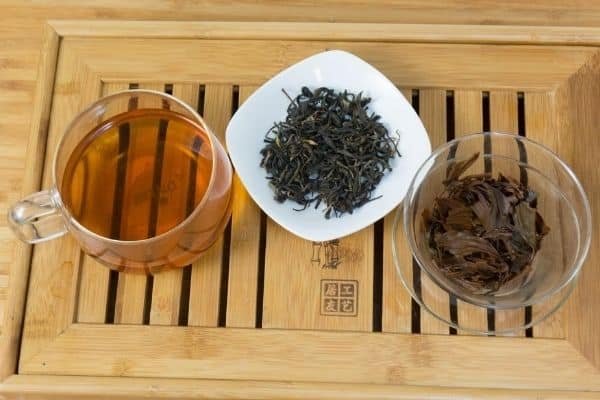
The tea leaves are wilted, rolled or cut, and allowed to oxidize fully until they turn black, then dried.
The process helps give the tea its red color, bold, nutty taste, and deep aroma.
The Chinese specialty Gongfu black tea is one of the most important representations of black tea.
The Chinese value black tea because of what they understand as of its potential health effects such as increasing appetite, eliminating water from the body, boosting heart health, and reducing blood pressure sugar, and cholesterol.
How to Prepare It
Depending on how strong you like your tea, brew it for a minimum of 30 seconds or as long as 3 minutes in hot water (190°F or 90°C).
We all have tasted black tea, but if you want to try a traditional Chinese one, you can order some Yunnan Gongfu Black Tea from Amazon.
Dark Tea
Dark teas are post-manufacture fermented teas. The best known is Pu-erh which is produced in Yunnan province. Other dark teas are made in other Chinese provinces.
Pu’erh tea is produced from a green tea made from the large-leafed Assamica varietal of the tea plant which grows as a native to Yunnan (and in Assam, Laos, Vietnam, etc).
To make the base green tea, the leaves are withered, panned, rolled and sun-dried. This green tea, known as Maocha (raw or rough tea) is then microbially fermented. The microbes are naturally in the tea because of where the tea bushes grow in the forested sub-tropical foothills of the Himalayas in Yunnan.
There are two types of Pu’erh tea.
The traditional type (called ‘Sheng’ or raw Pu’erh) is made as follows:
The Maocha is slightly dampened, compressed into cakes, and aged for a minimum of 7 – 10 years and often longer. As the tea ages, the microbial fermentation that takes place in the tea changes the color, aroma, flavor, and chemical composition of the tea.
Young raw Pu’erh tastes green and grassy; aged raw Pu’erhs are sweet and honeyed. The longer the tea is aged, the sweeter it becomes.
The modern type (called ‘Shou’ or ripened or cooked Pu’erh):
The Maocha is made very wet and is then heaped in huge warehouses and covered with plastic or cloth covers. The tea ferments quickly in a few weeks or months. The flavor profile and aroma are completely different from raw Pu’erh.
All ripened Pu’erhs tend to taste like wet soil, fish, earth, and damp wood.
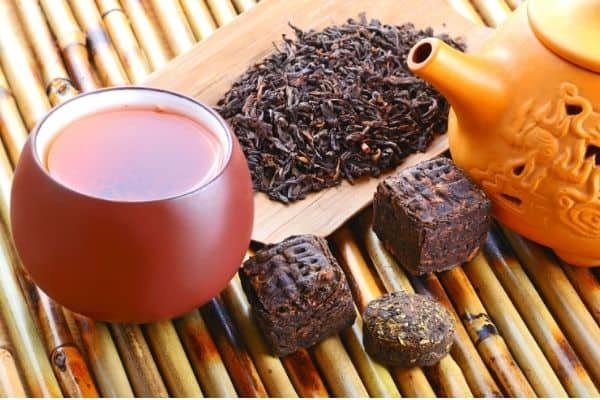
Revered by the Chinese for its medicinal benefits, which include reducing cholesterol levels and relieving hangovers. Pu-erh tea can also be used to quench thirst and aid digestion.
How to Prepare It
The Pu-erh leaves are rinsed in hot water for a few seconds, then infused in boiling hot water (212 °F / 100 °C) for 10-20 seconds.
They can be re-brewed several times. The Chinese brew dark teas in Gongfu style using a Yixing teapot or a Gaiwan.
If you want to try some high-quality traditional Pu-erh tea, get this Yunnan Longrun Pu-erh Tea from Amazon.
Here is an infographic that summarizes the facts about these 6 different Chinese teas (click to open a full-sized image):
Share this infographic on Pinterest: |
Chinese Herbal Infusions and Their Benefits
The health benefits of Chinese teas extend to herbal infusions as well. The people of China use herbal infusions, or tisanes, as a natural medicine for preventing and treating many health issues.
In TCM, herbs are grouped according to their energetic properties instead of their chemical makeup. Several herbs can be mixed together or teas and herbs (“yao chao cha” or “hua chao cha”) are prepared for medicinal purposes.
Here are some of the most important and potent Chinese herbal infusions that you should definitely try.
Reishi Mushroom
Reishi mushrooms, also known as Ganoderma lucidum and lingzhi, can be used to prepare a potent medicinal herbal infusion. They are grown plentiful in Jiangxi and Zhejiang and are primarily used in traditional Chinese medicine to balance Qi (vital energy).
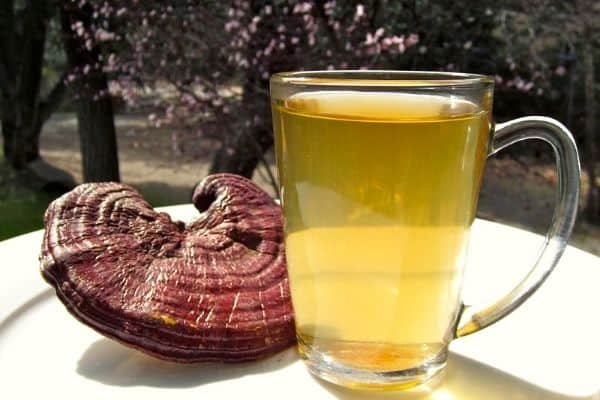
Reishi is a functional mushroom that has analgesic, antioxidant, anti-tumor, and other important health effects. It is thought to be good for the heart spleen, lungs, and digestive system.
The mushroom contains beta-glucans (polysaccharides) that helps support immune function and overall wellness.
It is also often used for cough, indigestion, poor appetite, general weakness, trouble breathing, forgetfulness, and insomnia.
I can recommend this excellent Organic Reishi Mushroom Blend available on Buddha Teas Online Store.
Ginger
Ginger, yang, is one of the most common herbs used to flavor Chinese food but is also used for making infusions. Freshly brewed ginger infusion has a lovely, slightly spicy flavor that awakens your senses.
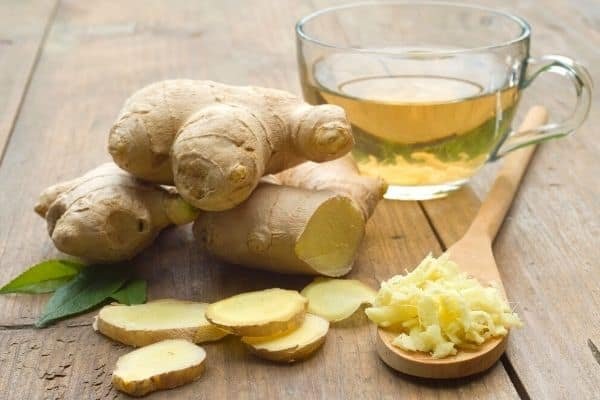
In China, ginger is a popular natural remedy for cough and flu. It is high in antioxidants and anti-inflammatory properties that make it a widely used plant for treating other health conditions including, nausea, upset stomach, high blood sugar, and arthritis.
There is a lot of scientific evidence that confirms the health benefits of ginger and its potential as a natural medicine to fight cancer and cardiovascular diseases.
You can find my favorite ginger tea products in this guide.
Ginseng
Ginseng (Ren Shen) is cultivated in Northeast China and is loaded with amino acids and anti-cancer elements. The Chinese consider it the best tonic and have used it for centuries to help relieve fatigue and to slow aging.
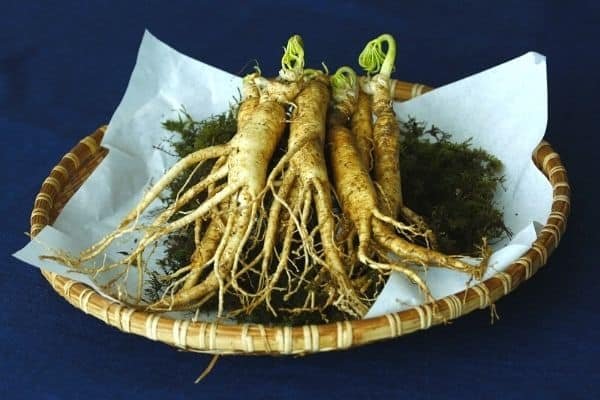
It is believed that ginseng tea is nourishing to the body and can help improve heart health, metabolism, eyesight, and soothe the nerves. It’s actually one of the best teas for libido and some people also use it to detox the body.
There is also plenty of research to back the health benefits of this herbal root tea.
Make your own infusion with dried or fresh ginseng root. Just steep the sliced or grated ginseng in freshly boiled water for about 10 minutes. You can add ginger and licorice root to make a super healthy and delicious herbal infusion!
Jujube
Jujube (hong zao cha), also called red dates, are grown mainly in Shandong, Xinjiang, Hebei, Shaanxi, and Shanxi. The herb is rich in vitamins A, B, and C, proteins, and organic acids. It is usually dried and sliced before brewing into a sweet, spicy, gingery infusion.
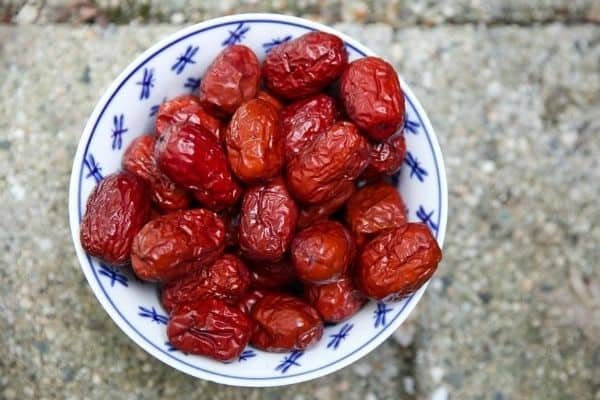
According to Chinese herbal medicinal theory, jujube helps relieve mental tension, calms the nerves, and improves memory.
Clinically, jujube is prescribed as a single herb or in sedatives combined with other herbal medicines, for the treatment of poor memory and insomnia. Jujube is also thought to enrich the blood, regulate menstruation, increase appetite, and boost immunity.
Want to try making some traditional Chinese jujube tea with ginger and black sugar? Here is an excellent recipe you can follow.
Chrysanthemum
Chrysanthemum, “ju hua,” blooms in different colors and are not just pretty, but the Chinese have been using the floral plant for centuries to relieve various conditions. The dried flowers are brewed to make an infusion that boasts a mild, flowery flavor similar to chamomile.
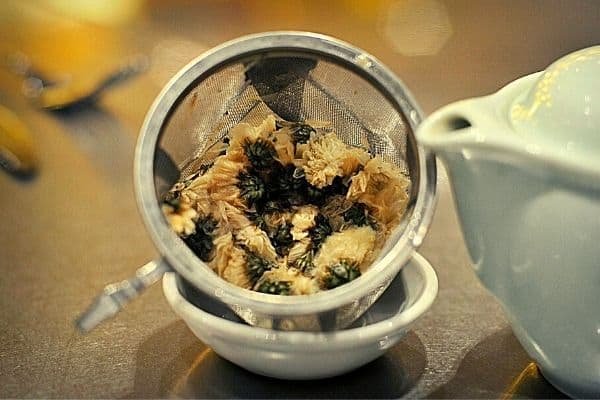
Fans of “ju hua,” say it is good for cold, fever, high blood pressure, hyperthyroidism, respiratory problems, and high blood pressure, calming the nerves and fighting inflammation.
There is also a study indicating that Chrysanthemum has compounds that can reduce inflammation.
You can order some Crysanthemum tea on Amazon and just steep the dried buds in hot water for 3 minutes to make a healthy infusion.
Honeysuckle
Honeysuckle seeds, leaves, and flowers have a long history of use in traditional Chinese medicine for cooling and detoxifying the body.
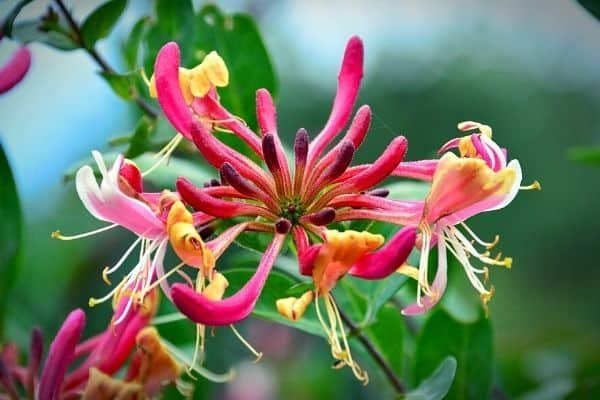
It has a slightly sweet yet bold medicinal taste. Some people blend it with other herbs to mellow out the strong medicinal flavor.
Honeysuckle, also called “woodbine,” is thought to help alleviate respiratory infections such as cold and flu. Some use honeysuckle to soothe and prevent sore throats.
In TCM, honeysuckle is combined with Chrysanthemum flowers to treat high blood pressure. In addition, it has anti-bacterial and anti-inflammatory properties that make it a good natural herb for fighting acute bronchitis and influenza A viruses (IVAs).
If you want to make some, you can order superb quality Organic Honeysuckle Flowers from Amazon. Use 1 teaspoon per cup of boiling water and steep 3-4 minutes to make the infusion. Throw some peppermint and licorice root in the mix to make it tastier!
Don’t Miss Out on the Health Benefits of Chinese Teas!
Chinese tea drinking is more than just a tradition. It is a way of life for all peoples, from the mansions to the mud huts.
One good reason to drink these teas and herbal infusions is their wide range of health benefits.
Instead of buying the tea or fresh herbs, you can just get a space-saving vertical garden kit and grow your own. Use a food dehydrator if you want to store the herbs and make your own tea blends.
Please post a comment below and tell me about your experiences related to Chinese teas and herbal infusions.
Enjoy your tea!
-Joonas
Save on Pinterest: |
